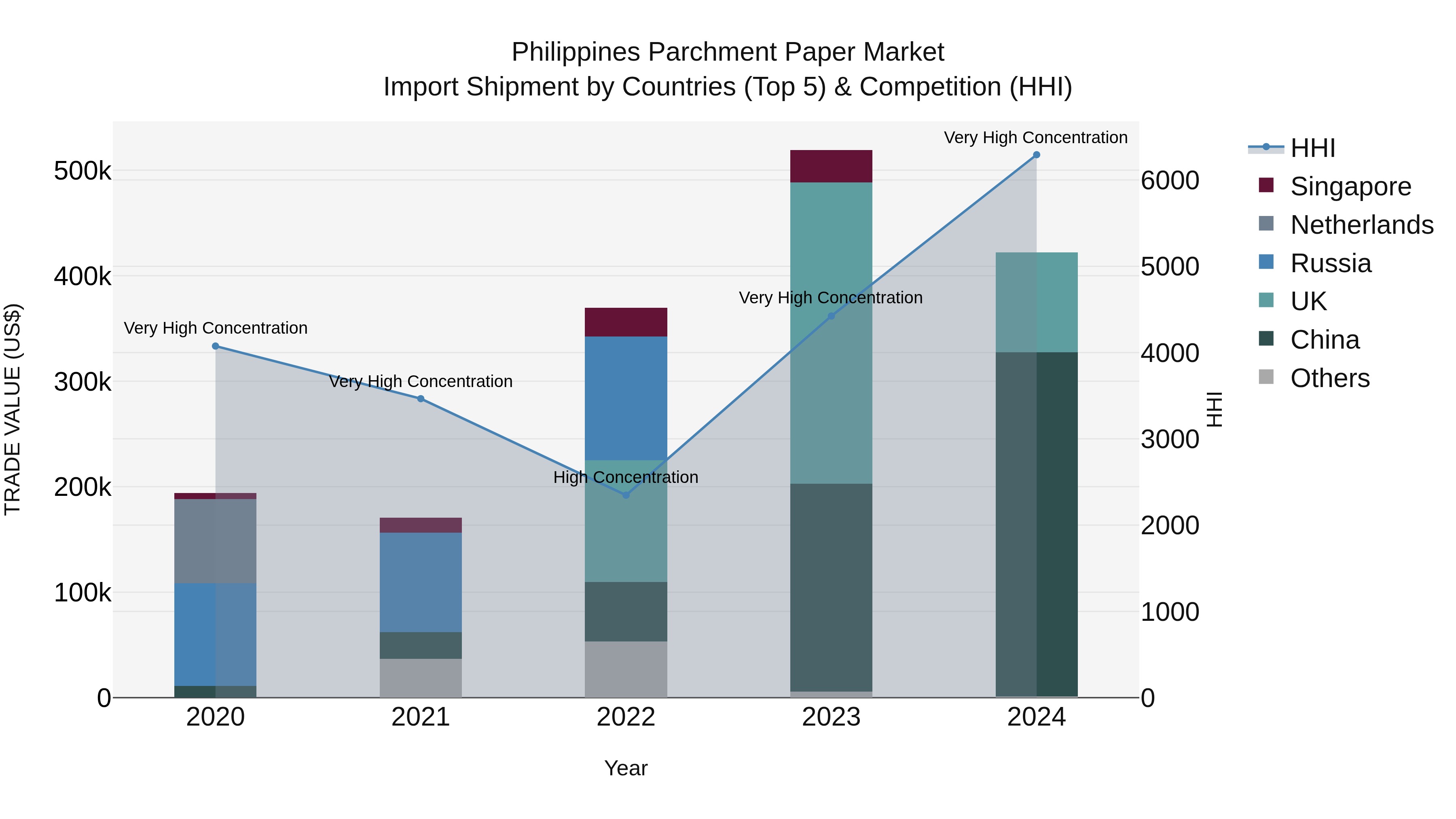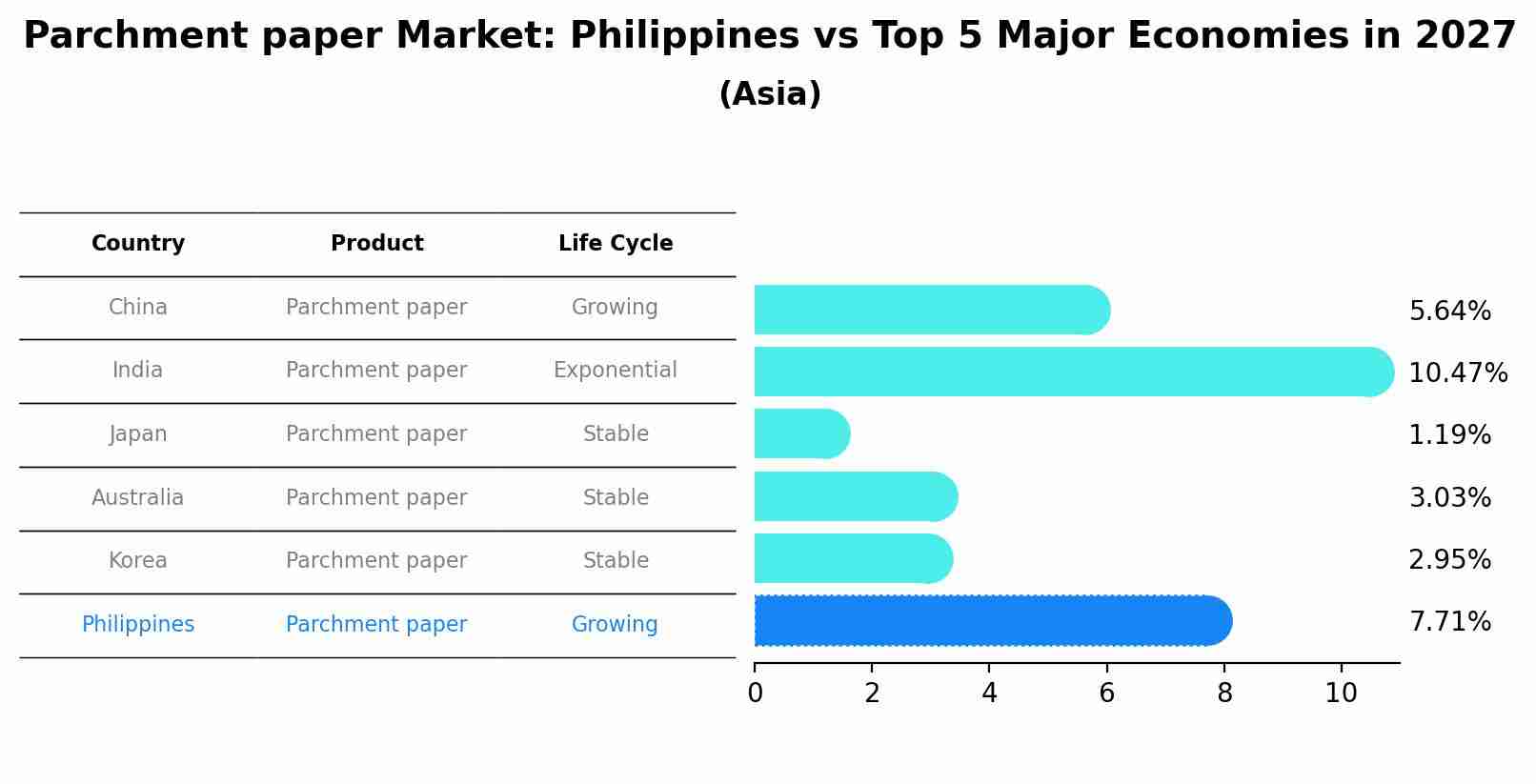Philippines Parchment paper Market (2025-2031) Outlook | Analysis, Industry, Revenue, Share, Forecast, Growth, Value, Size, Companies & Trends
| Product Code: ETC104088 | Publication Date: Jun 2021 | Updated Date: Nov 2025 | Product Type: Report | |
| Publisher: 6Wresearch | Author: Ravi Bhandari | No. of Pages: 70 | No. of Figures: 35 | No. of Tables: 5 |
Philippines Parchment Paper Market Top 5 Importing Countries and Market Competition (HHI) Analysis
In 2024, Philippines continued to rely heavily on parchment paper imports, with top exporters being China, UK, Canada, India, and Germany. The market remained highly concentrated, indicating limited competition. Despite a strong compound annual growth rate (CAGR) of 21.45% from 2020 to 2024, there was a notable decline in growth rate from 2023 to 2024 at -18.66%. This fluctuation suggests a potential shift in market dynamics or external factors impacting the demand for parchment paper imports in the Philippines.

Parchment paper Market: Philippines vs Top 5 Major Economies in 2027 (Asia)
The Parchment paper market in Philippines is projected to grow at a growing growth rate of 7.71% by 2027, within the Asia region led by China, along with other countries like India, Japan, Australia and South Korea, collectively shaping a dynamic and evolving market environment driven by innovation and increasing adoption of emerging technologies.

Philippines Parchment paper Market Synopsis
The parchment paper market in the Philippines is expected to grow at a CAGR of 8.4% during the forecast period. The increasing demand for baking and packaging applications, along with improved economic conditions, are some of the major factors driving growth in this market. Furthermore, growing health consciousness among consumers is also aiding market expansion. High availability of raw materials such as wood pulp and other fibers has stimulated efforts to increase production capacity.
Drivers of the market
The Philippines parchment paper market has witnessed growth due to its versatile applications in baking and cooking. Parchment paper is used to prevent sticking and ease food release during cooking, baking, and grilling. The market is driven by the expanding culinary culture, increasing home baking trends, and the demand for convenient and non-stick cooking solutions. Additionally, the growing interest in healthy and oil-free cooking has contributed to the popularity of parchment paper.
Challenges of the market
The Philippines parchment paper market encounters several challenges related to consumer preferences, cost, and environmental considerations. One challenge is the lack of widespread consumer awareness about the benefits and various uses of parchment paper in cooking and baking. Educating consumers about its advantages is essential for market growth. Cost considerations also play a role. Parchment paper might be perceived as a premium product compared to alternatives like aluminum foil or silicone baking mats. Convincing price-sensitive consumers of the long-term value of parchment paper can be a challenge. Environmental concerns, including sustainability and disposal, are increasingly important challenges. Parchment paper is often used once and then discarded, raising questions about its environmental impact. Addressing these concerns through eco-friendly production methods or promoting reusability could be crucial for market sustainability.
Covid-19 Impact of the market
The Philippines parchment paper market confronted challenges amid the COVID-19 pandemic. Parchment paper is utilized in baking, cooking, and food packaging. With lockdowns and restrictions affecting the hospitality industry and changing consumer habits, the market saw fluctuations in demand. Home baking and cooking gained popularity during the pandemic, leading to increased consumption of parchment paper. However, disruptions in the supply chain and manufacturing processes impacted availability. As the situation improves and businesses reopen, the market is expected to recover, driven by the resurgence of foodservice and culinary activities.
Key Players of the market
The Philippines parchment paper market is driven by the demand for convenient and non-stick baking and cooking solutions. Key players in this market include BakeEasy Supplies, ParchmentPro Philippines, and CulinaryCrafters. These companies offer a range of parchment paper products that cater to the needs of both professional chefs and home bakers, contributing to the culinary landscape of the country.
Key Highlights of the Report:
- Philippines Parchment paper Market Outlook
- Market Size of Philippines Parchment paper Market, 2024
- Forecast of Philippines Parchment paper Market, 2031
- Historical Data and Forecast of Philippines Parchment paper Revenues & Volume for the Period 2021-2031
- Philippines Parchment paper Market Trend Evolution
- Philippines Parchment paper Market Drivers and Challenges
- Philippines Parchment paper Price Trends
- Philippines Parchment paper Porter's Five Forces
- Philippines Parchment paper Industry Life Cycle
- Historical Data and Forecast of Philippines Parchment paper Market Revenues & Volume By Paper Grades for the Period 2021-2031
- Historical Data and Forecast of Philippines Parchment paper Market Revenues & Volume By Bleached for the Period 2021-2031
- Historical Data and Forecast of Philippines Parchment paper Market Revenues & Volume By Natural for the Period 2021-2031
- Historical Data and Forecast of Philippines Parchment paper Market Revenues & Volume By Resin Treated for the Period 2021-2031
- Historical Data and Forecast of Philippines Parchment paper Market Revenues & Volume By Others for the Period 2021-2031
- Historical Data and Forecast of Philippines Parchment paper Market Revenues & Volume By End-use for the Period 2021-2031
- Historical Data and Forecast of Philippines Parchment paper Market Revenues & Volume By Seafood for the Period 2021-2031
- Historical Data and Forecast of Philippines Parchment paper Market Revenues & Volume By Chicken for the Period 2021-2031
- Historical Data and Forecast of Philippines Parchment paper Market Revenues & Volume By Vegetables for the Period 2021-2031
- Historical Data and Forecast of Philippines Parchment paper Market Revenues & Volume By Others for the Period 2021-2031
- Philippines Parchment paper Import Export Trade Statistics
- Market Opportunity Assessment By Paper Grades
- Market Opportunity Assessment By End-use
- Philippines Parchment paper Top Companies Market Share
- Philippines Parchment paper Competitive Benchmarking By Technical and Operational Parameters
- Philippines Parchment paper Company Profiles
- Philippines Parchment paper Key Strategic Recommendations
Frequently Asked Questions About the Market Study (FAQs):
- Single User License$ 1,995
- Department License$ 2,400
- Site License$ 3,120
- Global License$ 3,795
Search
Thought Leadership and Analyst Meet
Our Clients
Related Reports
- Canada Oil and Gas Market (2026-2032) | Share, Segmentation, Value, Industry, Trends, Forecast, Analysis, Size & Revenue, Growth, Competitive Landscape, Outlook, Companies
- Germany Breakfast Food Market (2026-2032) | Industry, Share, Growth, Size, Companies, Value, Analysis, Revenue, Trends, Forecast & Outlook
- Australia Briquette Market (2025-2031) | Growth, Size, Revenue, Forecast, Analysis, Trends, Value, Share, Industry & Companies
- Vietnam System Integrator Market (2025-2031) | Size, Companies, Analysis, Industry, Value, Forecast, Growth, Trends, Revenue & Share
- ASEAN and Thailand Brain Health Supplements Market (2025-2031) | Strategy, Consumer Insights, Analysis, Investment Trends, Opportunities, Growth, Size, Share, Industry, Revenue, Segments, Value, Segmentation, Supply, Forecast, Restraints, Outlook, Competition, Drivers, Trends, Demand, Pricing Analysis, Competitive, Strategic Insights, Companies, Challenges
- ASEAN Bearings Market (2025-2031) | Strategy, Consumer Insights, Analysis, Investment Trends, Opportunities, Growth, Size, Share, Industry, Revenue, Segments, Value, Segmentation, Supply, Forecast, Restraints, Outlook, Competition, Drivers, Trends, Demand, Pricing Analysis, Competitive, Strategic Insights, Companies, Challenges
- Europe Flooring Market (2025-2031) | Outlook, Share, Industry, Trends, Forecast, Companies, Revenue, Size, Analysis, Growth & Value
- Saudi Arabia Manlift Market (2025-2031) | Outlook, Size, Growth, Trends, Companies, Industry, Revenue, Value, Share, Forecast & Analysis
- Uganda Excavator, Crane, and Wheel Loaders Market (2025-2031) | Strategy, Consumer Insights, Analysis, Investment Trends, Opportunities, Growth, Size, Share, Industry, Revenue, Segments, Value, Segmentation, Supply, Forecast, Restraints, Outlook, Competition, Drivers, Trends, Demand, Pricing Analysis, Competitive, Strategic Insights, Companies, Challenges
- Rwanda Excavator, Crane, and Wheel Loaders Market (2025-2031) | Strategy, Consumer Insights, Analysis, Investment Trends, Opportunities, Growth, Size, Share, Industry, Revenue, Segments, Value, Segmentation, Supply, Forecast, Restraints, Outlook, Competition, Drivers, Trends, Demand, Pricing Analysis, Competitive, Strategic Insights, Companies, Challenges
Industry Events and Analyst Meet
Whitepaper
- Middle East & Africa Commercial Security Market Click here to view more.
- Middle East & Africa Fire Safety Systems & Equipment Market Click here to view more.
- GCC Drone Market Click here to view more.
- Middle East Lighting Fixture Market Click here to view more.
- GCC Physical & Perimeter Security Market Click here to view more.
6WResearch In News
- Doha a strategic location for EV manufacturing hub: IPA Qatar
- Demand for luxury TVs surging in the GCC, says Samsung
- Empowering Growth: The Thriving Journey of Bangladesh’s Cable Industry
- Demand for luxury TVs surging in the GCC, says Samsung
- Video call with a traditional healer? Once unthinkable, it’s now common in South Africa
- Intelligent Buildings To Smooth GCC’s Path To Net Zero


















